Viewed 9281 times | words: 4707
Published on 2021-06-23 17:45:00 | words: 4707
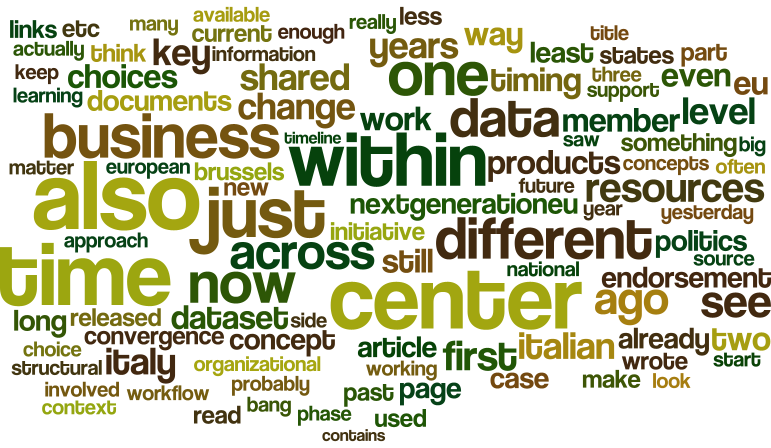
Yesterday, 2021-06-22, the three endorsements by the European Commission for Latvia, Germany, Italy were released, with three press conferences in three countries.
This article will be followed by others in the future, but I would like to start discussing what is within the title.
Therefore, take this article as a second part of a long introduction (the first part is here) about the themes that will be structural to #NextGenerationEU, from how it was announce and how aims to generate a system change across the whole EU27 half a decade.
Actually, before that, will have to share few "contextual" elements that "frame" that title.
The sections in this article:
_of workflows and keywords
_the concepts of time and timing
_purposes and convergence
Of workflows and keywords
If you were to read e.g. Italian newspapers, you could be forgiven if you missed that keyword within the title of the documents: "endorsement".
I released in early June 2021 a dataset (EU recovery and resilience facility current status) that, by definition, will evolve.
The first round of evolution was, obviously, the presentation of the proposals by Members States, their own "national plans for recovery and resilience" (in Italy is #PNRR, Piano Nazionale di Ripresa e Resilienza).
Again, as I learned in politics as a teenager (as member of the central committee of the Italian side of the Young European Federalists / Jeunes Européens fédéralistes), when I remember meetings discussing at length a single word or comma or phrase.
Incidentally: back then, we actually referenced the French acronym more often, JEF, or its Italian equivalent, GFE, as in the early 1980s French was still more common when talking about politics and political science, in Europe.
If you want, you can find that "Yes, Minister" episode on YouTube, on the UK approach on creating a "dis-united Europe"...
Now, despite today's newspapers titles here and there in Italy, it is still a little bit of a journey, as this is the workflow
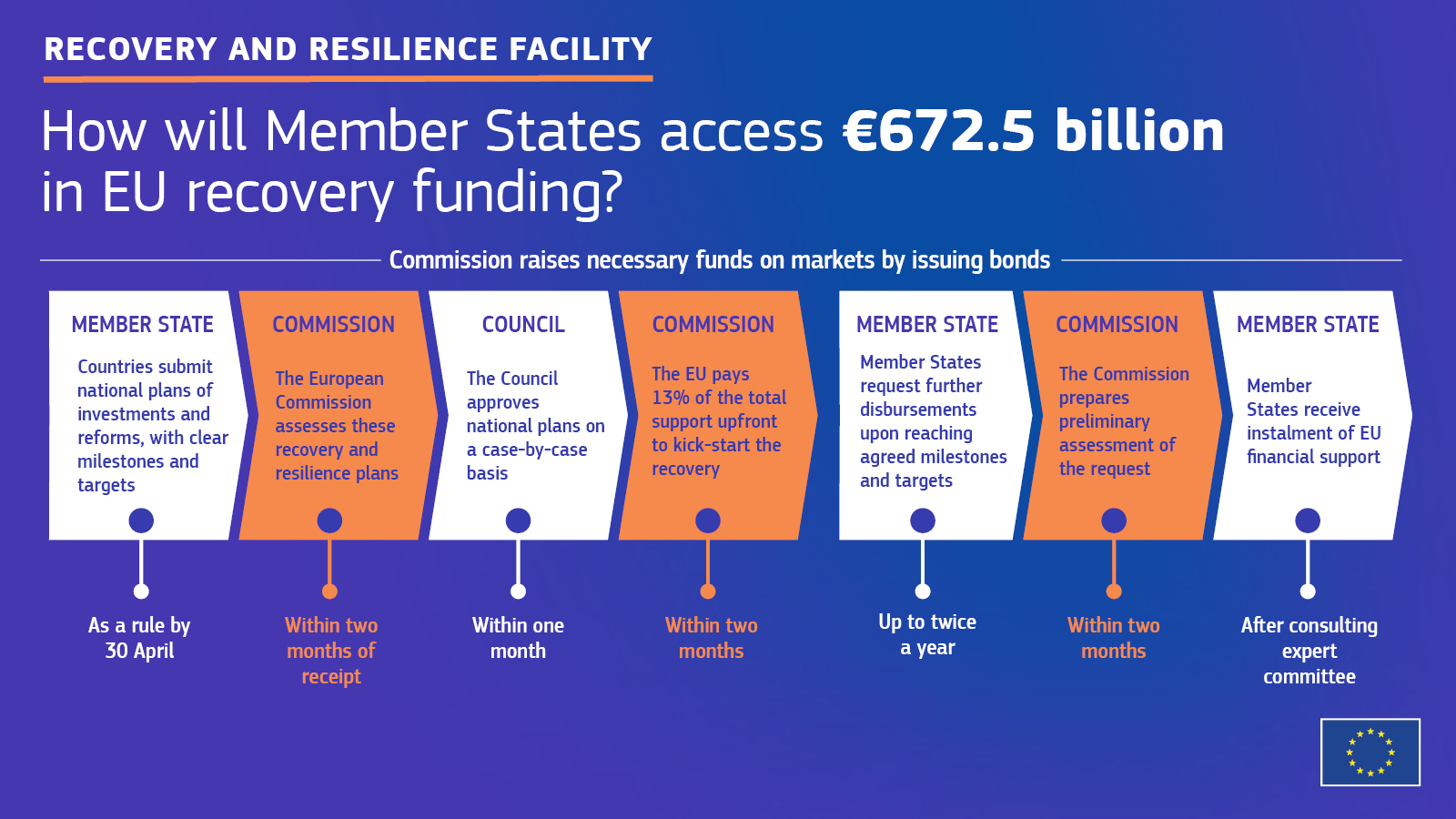
As befits any workflow, there are multiple steps, and each step has to leave a "paper trail" (being PDF trail, "digital paper trail"), to trace choices across time.
It has been since long ago (e.g. in my old 2003-2005 e-zine on change, BusinessFitnessMagazine) that shared a preference to document not only the positive, but also the negative choices (e.g. why other options were not selected), but I saw this approach considered acceptable only few times.
Pity, as ignoring the negative choices assumes that time travels just in one direction, while, in reality, in learning organizations, times travels in both directions.
No, not because learning organizations can travel back in time: simply, because learning implies also having memory of what worked and what did not work, and also contextualizing in time each choice and action.
The context can change, and reasons to discard an option could turn, in a different context, reasons to make a positive choice.
Moreover: while most often those who attended the first "decision point" are not going to be involved again, and, also if they were, their own personal context and experiences could influence not just their choices but also their analyses, overimposing their current context on the interpretation of past information.
We are just humans: and each day our human societies re-read past history using current events- why should organizations and organizational decision-makers be less human and have a more perfect ability to think as and how they were when the original decisions were made, if no documentation is kept?
If #NextGenerationEU and at least part of the #RRF element will become permanent, or at least "seed" future measures and approaches to EU-funding and disbursement, it would make sense to actually consider the current phase as something worth "logging", building an "audit trail" that could help future research on organizational improvement.
But while newspapers present choices in this case as "technical" choices, there is an underlying series of political priorities and choices.
I already shared some key data, e.g. yesterday within a Jupyter Notebook, with links to charts representing the priorities currently identified.
By choice, the notebook contains only references to key elements- analysis will be within future notebooks.
Anyway, also the dataset that I shared above follows (and will follow) the same workflow, i.e. contains data that represent the evolution of choices:
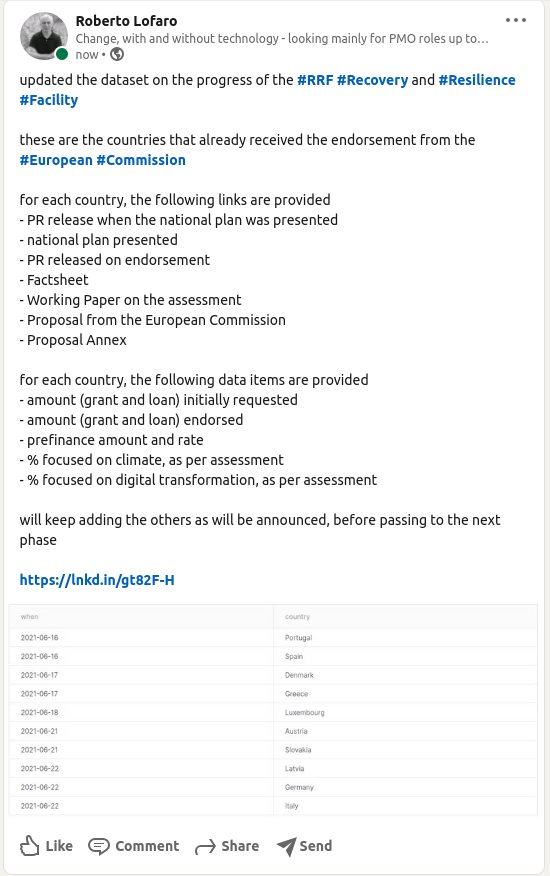
Therefore, remember that we are now at the "assessment" phase.
There is a silver lining: while the first communication phase (when the documents were presented by each Member State, and a press release was or was not published) was a little bit chaotic, at least now the communication seems to be following a format and a process.
The key element is always the same: traceability.
Which, at least, now starts being visible: so far, on the reference page, whenever an "endorsement" is released, a PR with more or less the same structure appears, containing always the same links to the same documents representing the "package" on each assessment and the ensuing endorsement; still a work in progress the titles, that could be easily harmonized.
Also, a summary page listing all the Member States (when assessed) with the relevant assessment and endorsement documents is now available, to ease access.
Would be nice to add a dashboard, as I routinely had to do in business (e.g. few years ago, was told by those in charge on the business and IT side on a change initiative "and, this is yours", as there were threads of related initiatives to be activated and tracked worldwide, I simply visualized in my mind how to connect them, created a table, and assigned a simple color code to enable "managing my degrees of exception"- the further divergent, the more focus of attention and "nudge"/support).
Yesterday I was asked if I am looking to become employed at the European Commission: the first time I was asked the question was in mid-2000s in Brussels, in a café, and probably those asking remember my answer back then, as I was open to the option provided that, as I said then half-jokingly, was less corrupt than Italian bureaucracies.
Well, I lived in Brussels long enough and have received enough formal and informal tests and interviews in and arouund Brussels while living there (and also thereafter), and have been offered to be a candidate in various contract roles, that, as I replied yesterday to my friend, if that really had been an option something would have happened already...
No, my interest now is within the line of my DataDemocracy approach, i.e. I really never saw a separation between society, politics, business, if you think systemically.
In our data-centric society it would be delusional to even think that technology can be left to technologists, business to business managers, and politics to professional politicians.
Open data in public affairs should be easier to access, more traceable, and subject to public scrutiny.
Then, at least part of the analyses, whatever the source, should be accessible to those who did not prepare it- with obvious constraint (e.g. national security, business confidentiality, competitiveness, etc).
Different interests have different boundaries, but at some level (the "data commons") they have a shared interest in that key concept, "interoperability", i.e. avoiding blatant bias that distorts and makes impossible to communicate and make informed decisions.
We have already enough dis- or ill-informed decisions, and a data-centric society risks creating so many layers of interpretation and distortion, that only a joint endeavour could produce an improvement.
As an example: over two decades ago, on risk in banking, to help integrate the requirements of different platforms (conceptually, we were in a negotiation phase), explored also integrating data from other sources that could help in "clustering" the targets of analysis, as what could be critical in an industry in a specific location, could instead be risky but acceptable in a different industry or location.
Within the dataset you will find, as I wrote above, the key data (and links also to the national plans, whenever available).
It is still puzzling that, even after having been presented and "augmented" (e.g. Estonia presented its plan few days ago, and Italy a while ago added 2500 pages), the "flag-based" table within the reference page contains only links to the first batch of documents.
But I have no doubt that eventually somebody will make it all more coherent across the timeline- meanwhile, whenever new information is made available, will add relevant links to the dataset, so that a simple CSV file of few KBs can be used as a single source across the whole lifecycle of the workflow shown above.
Obviously, if you look at the dataset, you will see that it already contains two files, the original one, and the one with the information about the assessments, that will be completed as more will be delivered (e.g. today added Belgium), but, to keep a single source, further related files will be added within the same dataset, and the description updated accordingly.
As I wrote above, new notebooks will be released when needed, but you can already use the dataset (or existing notebook) as a starting point, knowing that, at worst, the latest file will get more data (e.g. a radar chart on assessments now would cover 7 out of 27 Member States, but would automatically "inherit" more when available- would just need a re-run to get updated).
So, this is the right time to shift to the next section.
The concepts of time and timing
This morning by an Italian newspaper remembered that there is still a bit of a journey- also after ending the first block
.jpg)
Since the start of the COVID19 crisis, in Italy we had plenty of government decrees, laws, statements, etc- involving significant amounts of money.
Actually, on this website you can find two search webapps focused on a government decree, Decreto Rilancio and its conversion into a law, Legge 77/2020.
In Italy, "conversion" is neveer just a simple technicality, as e.g. some of my contacts in Brussels probably remember, when I summarized and translated a critical 90-something pages decree, and promised to do the same with the resulting law.
Then, dropped the ball when the law turned into 300+ pages of earmarks (an Italian tradition).
When you talk of 50-150bln EUR as in those two webapps (depends on the stage and source- better, the purpose of the communication), even in a country less bureaucratic than Italy, I do not see amounts.
I see structures, processes, budgets, etc.
And, more important, I see time.
Within the more recent webapp of the two, the webapp included just that: a concept about time and timing.
The reason? Something sounded here and there unusual, in official statements, so I went to the source.
And checked for something that, in cross-checking a more traditional business initiative, I would have looked for.
Or: do the resources' lifecycle match their planned use?
Are all the organizational structures involved provided the resources needed to operate?
As an example to make it more understandable: if you create a new office, either you provide resources that are currently available elsewhere, or you have to procure new resources.
In both cases, there is also the knowledge transfer issue, but let-s for now focus just on capacity planning.
If you start a new office, but with a charter without any limitation (i.e. not linked to a specific initiative), you are creating a structural cost.
If you start a competence center that will have also to generate a cultural change (as linked to the timeframe of another initiative), providing resources just for one or two years is not enough.
And so on, and so forth.
I hinted above about my past experiences in (organized, structural, advocacy) politics and Army bureaucracy- and in both cases saw different concepts of time and timing, e.g. in politics others sometimes identified the events, and then identified the potential sources of funding, while in the Army, at my level, the concept of costs appeared at my (really low) level only when we were looking for grants to support the barracks' library (different units, around 1200 people), and for the computers to use in the introductory information technology course that I had designed.
In business, worked across different industries on the number crunching side, but my number crunching involved also collating data from the operational side.
If you work in FMCG (fast moving consumer goods), e.g. producing and selling ice-cream, and generate hundreds of products each year, retiring or evolving most of them continuously, your concept of time is different from those who manufacture equipment or pharma products, both requiring years of investment, albeit the latter, when the product is ready, could have, as shown by vaccines, the same issues of ice-cream: a vaccine is, in the end, in this phase, a fast moving consumer good.
And if we keep having a patchy coverage worldwide, "variants" will keep appearing so fast, that it risks turning into an utility (i.e. continuous scheduledroutine "coverge reinforcement" rounds).
On the "virtual products" side, there is a difference between a financial institution selling the same product to millions using algorithms, with humans just acting as a mouthpiece (how many retail bank clerks understand the "structure" and concepts of the products that they have to sell?), to companies selling e.g. software development, where the training cycle of employees could be similar to the one of pharma, i.e. months to years, and not necessarily producing successful "products".
With a difference: at least for now (but technology, as already discussed by Womack in automotive decades ago, will soon make economically viable "mass-scale customization"), pharma still is related to volume, while in software or consulting we are talking about "automation" to ensure scalability, as adding ten more developers or consultants can be more time-intensive than adding a production line.
Last year was discussed that to convert existing pharma facilities to the new types of vaccines would take less than one year.
It is doubtful that you can "create" from zero a really productive programmer or business consultant in less time.
My first business experience of timing on a large scale was an automotive project in 1986, and saw how many different decision points and data flows with different timing were involved in proposing automatically to pay a single invoice.
My second similar business experience was a banking project, a general ledger, so had to see systemically across daily actions (e.g. the closing of each branch, and the reconciliation between branches overnight, etc), as well as the scheduled impacts of long-term commitments, and obviously the scheduled reporting, up to assets etc.
Then, first for a couple of years on Decision Support Systems, then for another couple of years on methodologies and associated change services, had a large array of projects covering more than half a dozen industries, each one with its own specifics in terms of products, markets, timeline, etc, as well as of course on investments and constraints (from regulatory to simply common sense due to their products/services, markets, distribution channels).
What matters is: the combination of resources, constraints, context, culture, aims defined in each case the actions (or models) had to work on.
Now, overall #NextGenerationEU, also if you just look at the six key priorities (or even just at "climate" and "digital"), needs a systemic approach.
I wrote in the past various articles on this theme, e.g. ranging to what happens when you have more people work from home instead of shuttling daily to offices and consuming products and services there, to the consequences of rearranging various industries to reduce their environmental impacts.
So, I will not repeat here: search e.g. for work, and sample some of the articles (hint: look at the address bar, and insert another word, if you want to search for something else)- generally, for articles until 2018 only in Italian, the search is anyway in English, as there is a "dictionary" to reconcile multiple Italian concepts to some key English words.
I wrote above that, in a data-centric society, separating technology, business, politics is delusional.
The flip-side of the coin is that bundling resources without guidelines is equally delusional, as the allocation of resources on the time and size scale adopted by the national plans, synchronized across all the 27 EU Member States is akin to "terraforming".
I know that some critics talk about the "size"- either to reduce the package, its timeline, or by comparing with more resources provided in the USA.
Frankly, I think that even a smaller package, with the same focus and instantaneous, synchronized rolling-out across the whole of EU would have a significant impact.
The size? Can be adjusted either way, and it is mainly to generate "traction" and motivation (and, hopefully, some "leverage").
But to reach in EU27 a shared level across the six pillars in just few years would be quite impressive.
Two days ago I saw the title of an Italian newspaper stating that "due to COVID Italy lost 9% of GDP", followed by the usual computations stating that GDP will return to 2019 levels in 2022.
It takes just a short walk as I did two days ago in Turin to see how that 9% is the tip of the iceberg and ignores the "time" dimension.
Turin used to have up to 1.4mln inhabitants, now is heading toward 800k, also if on the time leading to the 2006 Olympic Games (and after), plenty of .
But the surrounding areas increased the population, so many used to shuttle daily as far as 40km or more each way to work in Turin.
All those people used shops and had at least lunch in town, generating therefore all the associated logistics paraphernalia (and orders).
Which implied also, as shops were used to the routine, orders across the year sustaining many other businesses, as well as the associated infrastructure.
Yes, it is true that with current technologies it seems as if anything can be done in months- or even faster.
After years of theory on IoT and "smart cities", used the COVID19 lockdowns to start again working on both AI and electronics: both useful to experiment how to integrate data patterns in decision-making, when the game will become integrating unknown and unplanned sources and relying only interoperability, while assessing continuously data quality and security.
And it is interesting to see data flowing at different levels of time (in this case, frequency) and timing (in this case, synchronization and synchronization type).
But, unfortunately, with human decision-making, notably when mini- or micro-businesses are involved, it is a matter of trust: after few rounds of stop-and-go, including by giving access to loans guaranteed by the State to do the "interior redesign" needed to be COVID19-ready as a business, just to be then closed down...
...it is yet to be seen if those shutting down shops and small activities producing and delivering products to support in-town pre-COVID19 everyday life will re-open.
So, it is a matter of timing and trust.
And trust is also based on continuous, consistent, coherent communication and actions.
Which brings now to the "purposes" theme within the title.
Purposes and convergence
Already in the early 1980s, when, as part of political interests, started at GFE to read documents from Brussels and then Strasbourg, it was interesting to then listen at the explanation of what, otherwise, would seem as a collection of inconsistent minutiae.
Also with fewer Member States than now, defining "rules" was a matter of consensus wrapped into technocracy, not the other way around.
Because, as somebody wrote, if you twist data long enough, they will tell you whatever you want to listen to: that's what technical experts often end up doing.
So, after talking about resources (read the "working paper" on each endorsement from the European Commission) and time/timing (read the "annex" to each endorsement), it is time to get back to what actually should be the starting point, but way too often is forgotten.
This article, as you probably noticed, is not within the section "Citizen Audit", also if it is data-based, but within the same section focused on the future structure of organizations, where I published the previous article, Reinforcement learning and gamification within the #NextGenerationEU framework.
As you read within the previous sections of this article, I think that the key element of the overall #NextGenerationEU concept is the "big bang" linked to prioritization on few points (6) and specifically 2 (climate and digital), across the whole of EU 27 at the same time.
So, it is really in the line, accelerated, of few workshops that attended while living in Brussels on e-democracy, e-health, e-inclusion, and the like.
It is not anymore a matter of social or economic or digital divide: it is a matter of structural divide increased by a string of crises (Italy had de facto one few decades ago, we all shared the 2008 crisis, then the current one).
In any change initiative, it is not necessarily clear where you stand, while defining priorities, but when you collect from the bottom (each Member State, in this case), and consolidate up, you get a more realistic perception of the distance from where you should be, where you are, and where you would like to go.
When I did as PM/BA a similar "organizational profiling" activity in the early 2000s for an automotive company, it did not take long, courtesy prior experience both on change and automotive, to see different patterns, and the key element was working as I had done in similar activities in the past: keep being transparent with customer vs. the mandate you received, and keep monitoring "signals" to alert when adjustments are still possible, not just blindly follow a plan to deliver something that is blatantly irrelevant.
How do you compare qualitative information? As I wrote in the past, my favorite is converting into clusters on each dimension of analysis, and then build a "radar" chart: if done properly, allows to compare visually and then identify potential scenarios of...
...convergence.
You can have a look at the concept in more detail within the free version of "AI Organizational Scalability" (published in January 2021; follow the links within the description page, the low-cost paid version will be released this summer).
The concept here is simple: I heard about "convergence" associated with Europe for decades, even before the former COMECON (and USSR) Member States joined the EU, the Euro, or both.
We are still a long way from achieving that target, as I showed in previous articles discussing UN SDGs and EU (you can also see a dataset on that: UN SDG - EU 27 sample datamart (subset for 7 KPIs), released over one year ago).
There is a scorecard within the "working group assessment" document, and I selected those for the three countries whose "endorsement" has been announced yesterday, and another one showing how much the components of the each national plan cover the six pillars.
The name of the card? Social Scorecard- I think that the content is intuitive (you can read the original within the "working group" documents).
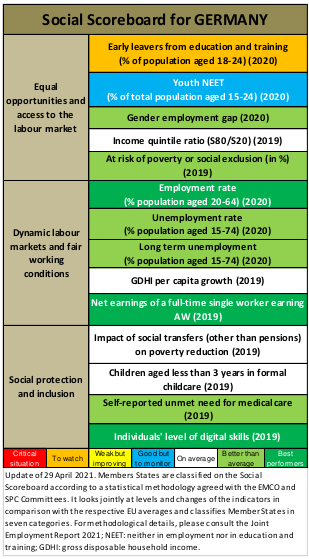
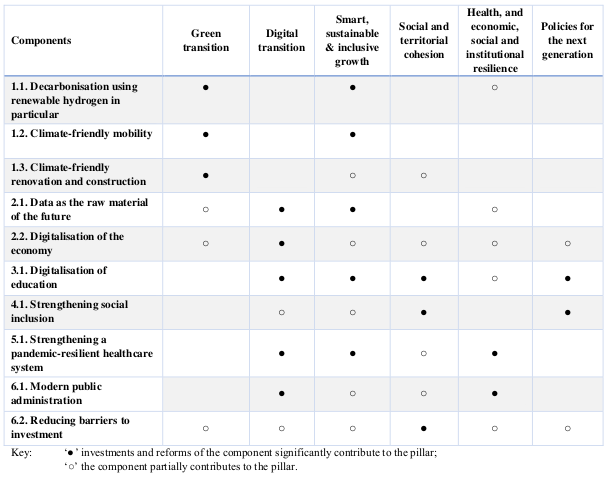
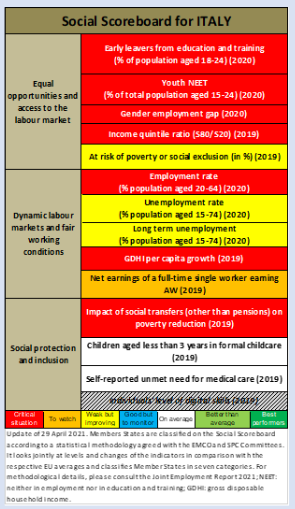
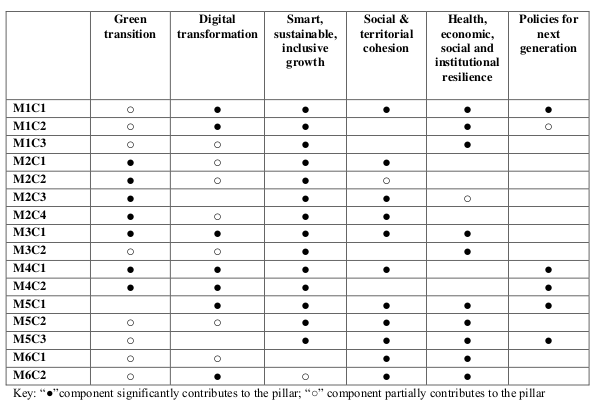
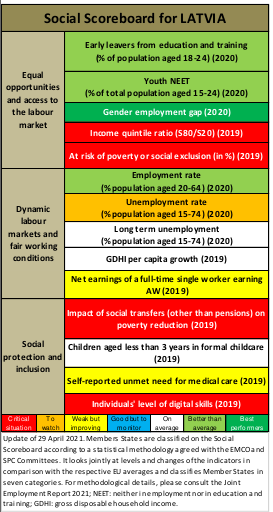
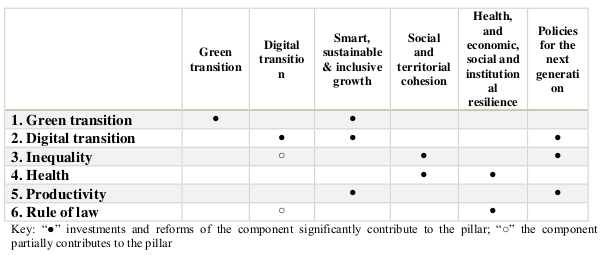
Now, somebody would expect a discussion on each one of the pictures- but, frankly, this article is just the second part (after the one on continuous learning) of a long introduction.
#NextGenerationEU is a first step that could probably strive to become what the workflow shown above hinted: not a once-in-a-lifetime initiative, but a way to test and develop a different structural configuration of the European Union.
Doing all that at the same time across the EU27 is what in business is called "big bang"- and, frankly, I am skeptical about the feasibility of big bang in most cases.
Also in busines, at best, it is an intentional way to level off differences and shift from harmonization to replication, sometimes a choice of desperation, sometimes a choice of "cultural colonization" that removes probably the reason why there were separate entities.
Imagine applying that to countries.
In reality, a "flexible big bang" approach is often more useful, allowing tuning intervention (and external support/control) to the specific starting conditions.
Even when, e.g. for compliance, is needed, a big bang could remain so conceptually (as e.g. in a fictional 200+ pages business case I shared few years ago, to support a book on planning).
Meaning: limited timeframe, specific targets, but then, as discussed in the example about change and radar chart, and the one on creating a dashboard with color coding to manage by exception, differentiating the convergence path and level of support/coordination/governance/management case-by-case.
As for the UN SDGs, also #NextGenerationEU and the 6 pillars can be seen as targets, but the way to reach each one, and at which level, is to be tuned.
What matters, is keeping momentum.
If you look just at those three countries represented in the charts shared above, you can see that here, too, this is the case.
So, it will be interesting to see how the differential convergence with be carried out, and the level of support/coordination/governance/management that will need to be shared at the EU level.
For the time being, stay tuned.
 _
_